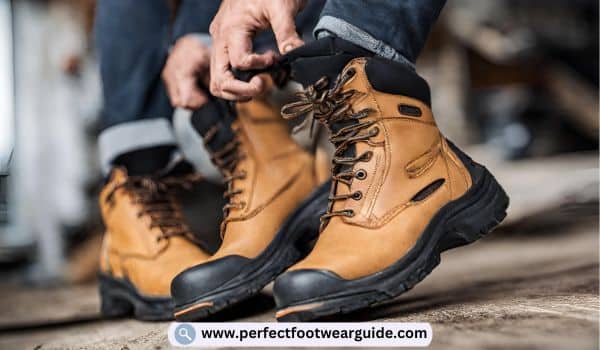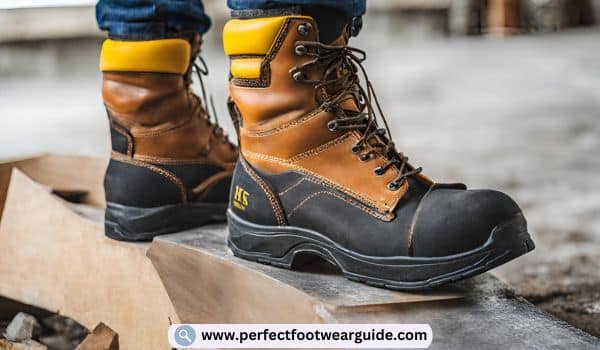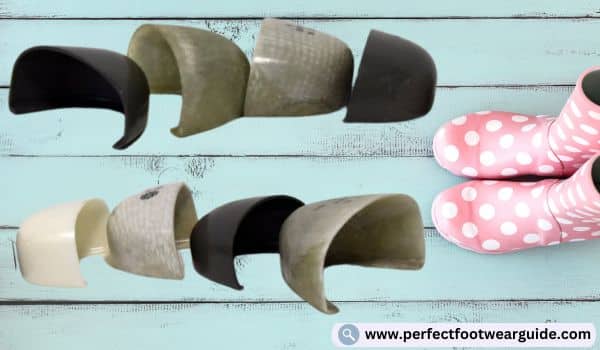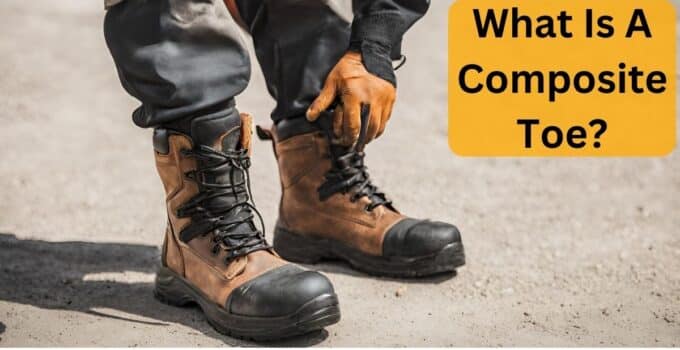Are you seeking reliable foot protection for dangerous work? What is a composite toe boot, and how can it keep you safe on the job? Here’s where to find it! This will ensure you have enough information about composite toe footwear to help you make good decisions about your safety equipment. We will cover everything from understanding the construction of composite toe boots to their advantages and applications. Check out and learn why workers in different fields choose composite toe boots.
What Is A Composite Toe?
Composite toe boots are built with innovative materials that provide excellent defence without heavy steel toes. These usually consist of high strength polymers, fiberglass, carbon fiber, and Kevlar, among other things. Each component adds to the composite toes’ overall durability and impact resistance.
Materials Used
High strength Polymers: Specialized polymers known for being durable and resilient are often prominently featured in composite toe boots. These polymers have been designed to withstand heavy impacts and compression forces while retaining their original form.
Fiberglass: By reinforcing them with fiberglass, there’s a further boost in strength given to composite toe boots. As such, this makes them extra light, boosting their ability to withstand heavy objects falling on them and compression hazards.
Carbon fiber: Its tremendous strength-to-weight ratios make it suitable for constructing a composite toe. Its advanced state offers improved protection without sacrificing comfort or flexibility.
Kevlar: Kevlar fibers exhibit exceptional toughness and resistance against abrasion, making them highly suitable materials for compound-toe shoe design. The fact that it is lightweight implies that, if it is included in the structure of a boot protective cap, one can easily notice punctures along with cuts while retaining a lighter version of its previous self.
Characteristics
Lightweight: These shoes are lightweight. Composite-toe boots offer similar protection to steel-toe shoes but with much fewer materials, thus allowing for more movement when worn all day.
Non-metallic: Composite toe boots cannot be metallic like steel ones. This is due to their high detectability of metal features. Thus, these can be used where workers work under a strict regime of nonmetallic substances. Besides, they don’t conduct electric currents, meaning one is safe from electric shocks.
Temperature resistance: These materials are typically made to withstand harsh temperatures and are commonly used in hot and cold places. They will protect you well as you work in an area with extreme temperatures, either very hot or cold. Still, they won’t make you feel uncomfortable.
These boots meet tough safety requirements yet still provide optimal comfort and performance because they come with advanced designs and materials that compose them.
Advantages of Composite Toe

Composite toe boots have numerous advantages, making them popular among employees in different industries. Some of the benefits associated with going for these kinds of footwear include enhanced safety measures and lighter-weight design:
Safety features
Impact resistance: Finally, composite toe boots were developed to resist severe impacts and compression forces, offering good foot protection against falling objects and other job-related hazards. The composite materials employed in the composition cap soak up any shock energy, reducing the risks of experiencing foot injuries.
Composite toe boots are durable and have reinforced toe caps that protect against puncture and sharp objects. Construction, manufacturing, and industrial workers can safely navigate hazardous environments without compromising safety.
Electrical hazard protection: Unlike steel-toe boots, composite-toe boots are not metal and do not conduct electricity. This makes them the best choice for electrical and utility industries, where they will protect your body from electric shock or injury.
Lightweight
Enhanced mobility: Because composite-toe boots weigh substantially less than those made with steel toes, they enable increased agility throughout the working day. Workers moving more freely and comfortably during a shift makes minimizing fatigue and discomfort associated with bulky footwear possible.
Reduced fatigue: People operating heavy machinery or climbing ladders should have lightweight shoes like composite-toe boots, as this relieves their feet of excess weight, hence preventing tiredness, which reduces work productivity. In other words, these weighty footwear do not affect the performance levels of employees.
Non Metallic
Metal detector friendly: Composite shoes are nonmetallic, meaning they cannot be detected in places with strict security checks in the form of metal detectors. They do not need to remove their composite shoes at the airport when it comes to passing through the security screening machines, unlike their colleagues who may be wearing shoes with steel toes having alarms ringing loudly due to that metallic content.
Corrosion resistance: Unlike steel-toe boots, composite-toe boots do not rust or corrode even when exposed to chemicals or harsh environmental conditions. As such, these boots last longer, making them cost-effective for employers since there is no need to buy new ones now and then because of corrosion caused by chemicals and environmental factors.
Composite-toe boots combine advanced safety features with lightweight comfort, making them ideal for workers who require reliable foot protection without sacrificing mobility or convenience. These innovative footwear designs perform better than any other type of shoe, thus setting benchmarks in office health across multiple settings.
Applications of Composite Toe

Composite-toe boots are versatile footwear for applications across various industries and work environments. Composite-toe boots offer essential foot safety measures and comfort in different roles, such as heavy construction sites and manufacturing facilities. These are some examples of where composite-toe shoes can be used.
Industrial settings
Construction: Construction workers face risks such as falling items, heavy machines, and sharp objects. Composite toe boots give you confidence in such situations because they maintain your mobility while providing the protection you require against common dangers in the area. They are, therefore, highly recommended for builders, roofers, carpenters, or framers involved in this area.
Warehousing: Loading dock operators who lift massive loads using forklifts or pallet jacks will find composite toe boots useful when preventing foot injuries arising from dropped cargo, rolling equipment, or even accidental impacts. These shoes have non metallic structures that ensure compliance with safety rules at transport hubs besides container terminals. Still, they do not set off metal detectors.
Logistics and transportation: One thing about truck drivers, delivery men and women, and logisticians is that they stand all day long loading and unloading goods in various climatic conditions. However, composite toe boots can protect their toes from shifting loads and other hazards associated with transportation. These are designed without metal parts, meeting the safety regulations for freight handlers at major vaccination sites like airports or train stations.
Construction
Manufacturing: Manufacturing has many hazards, like heavy equipment, moving parts, and cutting tools. Composite-toe shoes are secure since they are light and lack the discomfort of steel-toe boots, but they are still very protective of the feet. Individuals in the automotive, aerospace, and electronics sectors can use composite-toe shoes to be safe at work.
Machining and fabrication: Some employees, such as welders, machinists, and fabricators, handle huge machines that may cause foot diseases from sharp corners, hot surfaces, or flying materials. As with other forms of PPEs, composite toe boots protect without interfering with the flexibility levels required for precision tasks. This makes them suitable in environments where one is likely to encounter electrical faults.
Manufacturing
Utilities and maintenance: For those working in utility services, including electricity works, plumbing works, and HVAC maintenance, having slippers that would keep their feet safe from electrocution or punctures while also enhancing friction so one does not slip is vital. The boots of composite toes still match these conditions while being light enough to climb ladders, enter small spaces, or cross uneven territory. Also, these boots do not conduct electricity, which prevents electrical shocks in places where this hazard is present.
Composite boots are designed to meet the demands of challenging work environments where workers require foot protection yet need not sacrifice their comfort or performance. Whether in construction, manufacturing, warehousing, or utility services, composite toe footwear guarantees a worker’s safety and productivity during his duties.
Comparison with other toe protection options

Different alternatives for toe protection have benefits and drawbacks when deciding on appropriate shoes for specific jobs. Now let’s consider composite toe boots from among other commonly used types of toe protection:
Steel Toe
Strengths: Traditional steel-toed boots have been known for their durability and impact resistance for years. The steel cap is an ideal protective shield against objects that may be too heavy or require certain forces of compression, thus making them a common preference among sectors like construction and manufacturing.
Steel toes are more pocket-friendly than composites, making them affordable to people on tight budgets.
Limitations: Unlike composites, steel toes are heavy and bulky, so they can cause discomfort or fatigue if worn for long hours.
Steel caps conduct electricity and may expose workers to electrical dangers in certain working conditions.
It is worth mentioning that steel toes are very cold, especially during winter, posing the threat of frostbite and extreme discomfort.
Alloy Toe
Strengths: These boots use lightweight materials like aluminum and titanium to make the caps. Therefore, they provide strength while being lighter than steel-toed ones.
Compared with alloy ones, alloy cap shoes give better satisfaction in impact resistance since they offer more comfort and flexibility than their counterparts made of steel. Some alloy-toe boot models have high-temperature tolerance levels.
Thus, they can be worn by those who operate under extreme hot or cold weather conditions commonly experienced in this country.
Limitations: Some alloy-toe boots might be much more expensive than Steel-Toe Boots; therefore, only some workers can afford them.
Despite being lighter than steel-toe boots, alloy caps might be heavier than composite-toe boots, leading to fatigue over time.
Conversely, alloy toe caps do not provide as good puncture protection as composite toe caps in certain hazardous environments.
Composite Toe
Strengths: Composite toe boots are constructed using advanced materials such as fiberglass, carbon fiber, and Kevlar, offering superior strength and impact resistance while remaining lightweight and flexible.
Non-metallic in nature, the composite cap does not conduct electricity, making it preferable to workers in the electrical and utility industries.
The puncture-resistant capability of composite-toe boots is excellent, so they can be applied in a wide range of jobs, like building projects or making products, especially those that involve chemicals inside them or lying on the surface of shoes used by human beings who live under normal weather conditions, including, but not limited to warehouses.
Limitations: Although they are often more expensive than steel safety toes, many people find composites more comfortable while providing better protection against impacts.
These durable caps are less resistant to extreme impacts than steel ones. Nevertheless, they still satisfactorily guard against most job hazards.
Some employees may prefer the conventional appearance of steel-toed boots. However, composites have gained much popularity due to the development witnessed in this area during recent years.
Composite boots are durable, lightweight, and versatile, making them ideal for people working in different sectors. Compared to steel-toe boots and alloy-toe boots, composite-toe boots present a modern alternative that emphasizes comfort, security, and performance in work environments.
Conclusion
Composite toe boots are best for workers who want reliable foot protection without losing comfort or performance. Their advanced materials and innovative designs give them outstanding strength and impact resistance, making them suitable for many industries and work environments. Workers trust composite toe boots to protect them from falling objects, punctures, and electrical hazards at construction sites and manufacturing areas.
Additionally, their light weight and lack of metallic properties help increase movement, decrease fatigue, and ensure optimum comfort throughout the working period. Composite toe footwear continues to be a top choice for modern workers who prioritize safety, comfort, and efficiency with ever-changing workplace safety standards.
Frequently Asked Questions (FAQs)
The following questions and answers will help you choose composite toe boots:
How do composite toe boots differ from steel toe boots?
Composite toe boots have lightweight, non-metallic toe caps, unlike steel ones, which are made of metal. For this reason, such a variant is lighter and more convenient for prolonged use.
Are composite toe boots as safe as steel toe boots?
Yes, these shoes are engineered to meet or exceed the minimum requirements of organizations such as ASTM International and OSHA regarding impact and compression protection. Although they might offer less security than steel-toe shoes, composite-toe boots provide enough safety on most job sites.
Do composite toe boots set off metal detectors?
Metal detectors will only recognize such shoes if they are made from non-substantial metallic material like fiberglass. Therefore, these items are good for people working at airports or special facilities requiring screening through such systems.
Are composite toe boots suitable for electrical hazard environments?
Yes, they do not conduct electricity like those made of steel; hence, they can be considered to be non-conductive. This aspect makes them safer than their counterparts when used by employees who work under circumstances where electric dangers exist, thus reducing the chances of shocks.
Do composite toe boots provide insulation against extreme temperatures?
Yes, such shoes provide better insulation against extreme temperatures than their steel-toed counterparts. The composition caps do not contain metals, which implies that they retain some heat when individuals put on these shoes during cold times, while ice does not melt even if worn during the summer.
Are composite toe boots suitable for all types of work environments?
These boots are ideal for use in various work settings, such as construction sites, factories, stores, and distribution centers. Still, you should always consider the dangers at your workplace and choose shoes that provide enough protection.
Do composite toe boots come in different styles and designs?
They come in many styles and designs to suit different people’s tastes or job requirements. You can buy a variety of them, depending on whether you need waterproof boots, anti-slip soles, or those with added features meant for a certain industry, such as oil and gas exploration.







